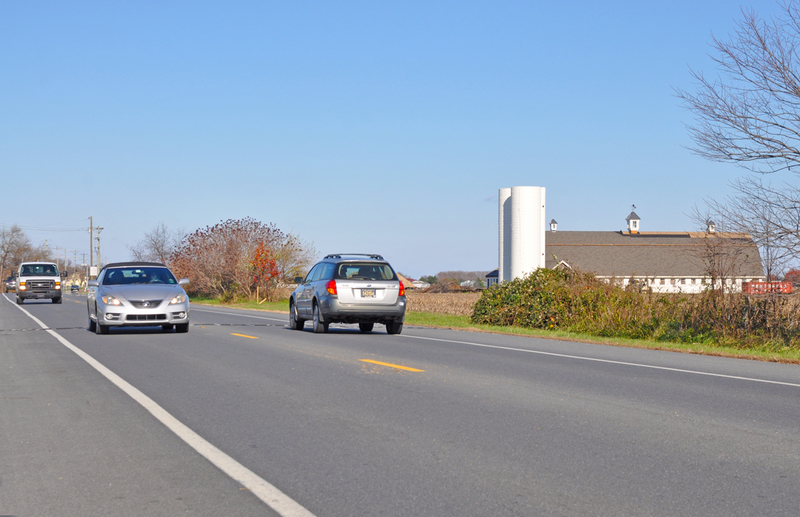Lewes reviews traffic impacts of Village Center, future development
If all developable land along Kings Highway and Gills Neck Road outside Lewes is built out over the next 30 years, it could result in as many as 51,000 new vehicle trips per day, says a Lewes planning consultant.
Environmental Resources Management certified planner Ben Sussman presented the findings of a traffic impact assessment at a Lewes Mayor and City Council workshop Nov. 30. While the main focus of the discussion is the proposed Gills Neck Village Center, the study looked holistically at future traffic in the area.
ERM estimates that if all available land is developed east of Savannah Road, more than 36,000 new daily trips will be added to the area-wide road network. During peak travel season, Sussman said, that number could increase 40 percent to 51,000 trips per day.
Jack Lingo Asset Management, the applicant for Village Center, disputes the study, saying the consultant failed to obtain key documents that would provide relevant information.
After reviewing the information and comments from residents, council will revisit the topic at its Monday, Dec. 14 monthly meeting.
ERM'S RECOMMENDATIONS
• Add a developer-funded traffic study for the intersection of Savannah Road, Gills Neck Road and Front Street.
• Require developer-funded traffic studies to reflect a more distant future year rather than project opening day. Suggested: 2030.
• Work with DelDOT to establish a Transportation Improvement District to include all of greater Lewes to ensure holistic consideration of the effect of traffic resulting from developments.
• Develop a memorandum of understanding with DelDOT that establishes formal consultation between DelDOT and the city for development proposals that directly affect the city's transportation system.
• Repeat the request that the Monroe Avenue entrance to Showfield be constructed as part of Phase 1.
• Support recommendations from the Lewes Scenic and Historic Byway Corridor Management Plan.
ERM's findings
Sussman said his organization looked at every parcel within the study area. For land now planned for development or available to be developed in the future, he said, his group applied factors to determine a reasonable estimate of new housing units. For developable parcels zoned AR-1, he said, the study assumed a developer would seek upzoning to the next level.
“It's certainly possible to develop under AR-1, but we wanted to look at a reasonable future scenario,” he said.
ERM found Kings Highway traffic could potentially exceed its capacity at intersections and on straight-line segments of the road to the point where the existing two lanes might not accommodate traffic.
ERM is also concerned there has been no study to determine the impact of development on the intersection of Gills Neck Road, Savannah Road and Front Street, at the Dogfish Inn. Sussman said he suspects the intersection may already be at or near its maximum capacity in the summer.
The consultant noted the developer of Village Center is using a 2006 traffic impact study as part of its application for rezoning.
“Our feeling is that the 2006 study is essentially old and that ground systems have changed and assumptions have changed,” Sussman said. “It is worthy of a refresh. We understand DelDOT has accepted that study as being valid for continuing purposes. We as the city’s consultant respectfully disagree.”
As traffic increases, ERM believes more motorists will use residential streets as shortcuts. Kings Highway and Freeman Highway are intended to be multipurpose roads, but most of Lewes' streets are not, Sussman said.
“It already happens on crowded weekends,” he said. “There's no reason to think it wouldn't happen with more traffic on the roads, or that people wouldn't find more creative ways to get downtown.”
Sussman also cited public safety concerns. With Lewes positioning itself as an extremely bike-friendly community with the recent opening of the Junction and Breakwater Trail extension and the planned Lewes to Georgetown Rail to Trail, he said, more traffic could create safety issues with bicyclists.
“Lewes is obviously a hub ... given its location and given the state park,” he said. “More traffic plus more interest in bike and ped equals a greater chance for potential conflicts.”
Alternatives
Looking specifically at the proposed Village Center plan, ERM estimates more than 14,000 daily trips will be added. The developer is seeking to rezone 36.5 acres from AR-1 to CR-1 to build a 215,000-square-foot shopping center. The plan includes six pad sites along Kings Highway, plus 27 acres for a YMCA and cultural center not part of the rezoning request. According to the Gills Neck Village Center website, the goal of the shopping center is to eliminate the use of cars and promote a green, healthy lifestyle for the residents of Gills Neck Road by providing walkable access to everyday necessities and services.
Other zoning classifications would reduce traffic impact, the consultant says. If the land were rezoned and developed under B1, neighborhood business district, Sussman said, ERM estimates an average of 7,242 daily trips, or about half the estimated traffic generated under the existing proposal. If developed under MR, medium-density residential, ERM estimates 4,764 daily trips.
“We didn't want this report to appear as an all-or-nothing proposition,” Sussman said. “We wanted to at least look at what could be the potential development and the potential traffic impacts of that type of development if a different concept were applied.”
As a result of the study, ERM offered several recommendations, including further developer-funded traffic studies and better communication among the city, county and state.
“The purpose of the report is not to take a position, but it is to provide information [and] recommendations that can inform the city’s discussions with state agencies, with Sussex County and other interested parties regarding development, planning and transportation issues in the greater Lewes area,” Sussman said.
Developer disputes report
Nick Hammonds, principal at Jack Lingo Asset Management, sent an email to mayor and city council Nov. 30, listing concerns about the report. After analyzing the study, he said, he found the report incomplete with many factual inaccuracies. He asked that the city's Nov. 30 workshop be postponed until corrections to the report could be made, but city council held the meeting anyway.
“Substantial resources (ours, DelDOT’s, and DelDOT’s consultants) have been invested into this effort already,” Hammonds said. “We believe the city should ensure their report has the most accurate information and facts, and we have certain questions about what is in the report. Based on this, we thought it would be prudent to discuss these questions before the information was presented and potentially accepted as fact by the public.”
Hammonds said it appears ERM did not review a 2006 traffic impact study, a 2008 TIS study letter written by a DelDOT consultant or the resulting 2009 letter agreement between LT Associates and DelDOT.
He said each document contemplated a more intense land use for both the Village Center property – originally calling for a 520,000-square-foot shopping center – and developments on Gills Neck Road. As a result, traffic projections that were used to determine required developer improvements are higher than what will be generated from the current proposal. Those traffic projections, he said, were the basis of the letter agreement between LT Associates and DelDOT for developer-funded traffic improvements, some of which have already occurred.
Sussman said a request was made for the 2006 study, but it was not granted. However, Mayor Ted Becker said the city has received a copy.
A copy of ERM's traffic impact assessment can be found under City News & Notices on the city's website ci.lewes.de.us. For a full history of the Village Center saga, check out Ron MacArthur's article from March 27.
Residents react to report
By Nick Roth
Following the Nov. 30 presentation by Environmental Resources Management planner Ben Sussman, the dozens of residents in attendance had their opportunity to speak.
Some residents were concerned ERM's traffic estimates were low. If the developer is granted the CR-1 zoning it seeks, many fear it will create a domino effect, providing other nearby landowners an easier path to rezoning. Two vacant parcels of concern are the Mitchell property, across Gills Neck Road from the proposed Village Center, and the Townsend property, at the corner of Kings Highway and Clay Road. Together, they represent more than 120 acres of developable land.
“If this [Village Center] land goes to CR-1 zoning, it will immediately increase in value,” said Franklin Avenue resident Colin Norman. “Once this one goes CR-1, all of the [other developable] land is vulnerable as well. The developers will argue they are already in a commercial zone, and it will be relatively easy to get.”
If approved, Pilottown Road resident John Mateyko said, traffic caused by Village Center and future development would be insufferable and character-changing. He called on the city to hire a full-time planner to help the effort.
“We need more professional help,” he said.
Kim Ayvazian, a Lewes resident for nearly three decades, recognized the importance of the traffic study; however, she said, the scope needs to show the impact on the entire city, not just half of it.
“There are hundreds of developable acres on New Road,” she said. “And DelDOT, in its infinite wisdom, has decided to make it easier to access New Road from Route 1. The report should ideally look at all of the municipal city of Lewes because the development is going to squeeze us on all three sides.”
DelDOT has announced plans to build an underpass at the Nassau Bridge, providing a safer route to access New Road. Construction is not scheduled until fiscal year 2020.
Leslie Ledogard, a resident of Retreat at Love Creek, said it only makes sense to engage in regional planning for the entire area. With a regional plan in place, she said, projects can be planned and coordinated for smart growth.
“I am not against development; I am for planned development,” she said. “I am for looking at things from a 30,000-foot perspective. People move here because this is an amazing, great area to live. We need to look at this entire area before it's too late.”
Fourth Street resident David Greer said the problem is the county and its zoning code.
“I think what we should do is have a study as how to stop this damn foolishness,” he said. “There must be some way of changing the zoning in this county. There must be some way of talking to county council and having some sort of understanding that we can’t keep going on like this. If every piece of land is built on then there’s not a damn thing we can do but move out.”
















































